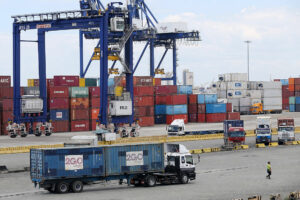THE PHILIPPINES is past the worst point of its trade slump, though growth may remain weak going forward, Pantheon Macroeconomics said.
“A sustained acceleration in year-over-year trade growth is unlikely in the current climate, but we’re confident that the worst is over,” it said in latest Emerging Asia Economic Monitor report.
The report, written by Chief Emerging Asia Economist Miguel Chanco and Senior Asia Economist Moorthy Krshnan, said that while the Philippines’ trade performance is beating expectations, a “big surge” in growth is not expected.
“Two-way trade growth in the Philippines looks to have turned a real corner in the second quarter… trends at the margin have been on the mend for months, and this continued in May,” it added.
The Philippine Statistics Authority reported that the trade deficit narrowed to a three-month low of $4.4 billion in May.
In the first five months, the trade deficit was $23.99 billion, little changed from the $23.96-billion deficit posted a year earlier.
The Philippines is a net importer, incurring a trade deficit for the last eight years since the last surplus of $64.95 million in May 2015.
“The year-over-year improvement should hold, as short-term trends have been recovering for months,” it added.
Meanwhile, Pantheon Macroeconomics also noted that export growth may moderate.
“One reason why stability, rather than a surge, in export growth looks more likely, for now, is that we’ve yet to see a U-turn in year-over-year export growth in Korea, a much larger player in global semiconductors,” it said.
“Semiconductors effectively have been driving the rise in total Philippine exports single-handedly from the latter’s nadir in February. And the bad news is that their upswing since March probably is unsustainable, as the sector appears now to be in a glut of supply globally,” it added.
During the five-month period, exports declined 11.5% to $28.21 billion, missing the government’s 1% growth target this year.
More than half (54%) of total exports were electronic products. Electronics exports fell 12.8% to $15.37 billion, of which semiconductor exports declined 9.7% to $12.07 billion.
“In terms of import growth, the outperformance in consumer goods is fragile, owing to the structural headwinds facing households. Meanwhile, capital goods imports likely will remain under pressure from high interest rates and subdued capex plans,” Pantheon Macroeconomics added.
In the first five months, imports fell 6.6% to $52.2 billion. The government had set a growth target of 2% for the year.
Imports of capital goods fell 5.8% to $15.05 billion, while imports of consumer goods rose 15.6% to $9.59 billion. — Luisa Maria Jacinta C. Jocson

